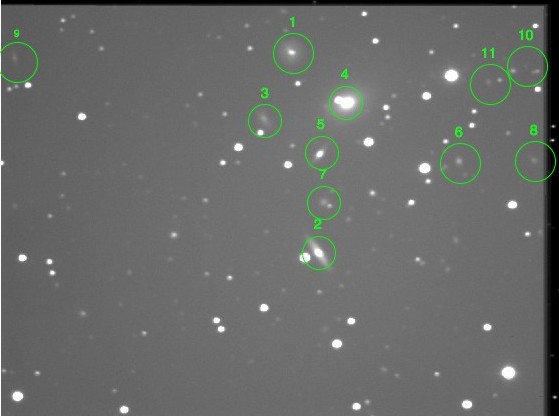Wow- those are a loooong way away...
 About a week ago I took an an astrophoto of a galaxy cluster, those of you who know me on Facebook have already seen the shot (some possibly on Twitter as well). Though I provided some basic information about the photo, I didn't really do much analysis of it. So this post is to provide that analysis about my first attempt at a really deep (for me) astrophoto. There's a copy of the photo after the cut.
About a week ago I took an an astrophoto of a galaxy cluster, those of you who know me on Facebook have already seen the shot (some possibly on Twitter as well). Though I provided some basic information about the photo, I didn't really do much analysis of it. So this post is to provide that analysis about my first attempt at a really deep (for me) astrophoto. There's a copy of the photo after the cut.
The shot above is the final image after processing (the one originally posted in other forums). Click on the image to enlarge to it's full size.
The basic information about the photo:
- Taken with the 14" Celstron C-14 located at the RASC Calgary Centre's Wilson Coulee Observatory.
- The image was taken with a monochrom (B&W) imager. To get colour a total of four filters were used and then combined later.
- The luminance filter (L) is basically an unfiltered shot of the object which provides the overall brightness information. In this instance the L channel was made up of nine, 10 minute shots stacked together with software for a total exposure time of 90 minutes.
- The red (R), green (G) and blue (B) channels which provided the colour information were each made up of three, 10 minute shots stacked together for a total of 30 minutes of exposure per channel. The image covers a part of the sky that is 12.5x9.3 arc minutes or an area of about 116 square arc minutes. For comparison the full Moon is about 30 arc minutes across and has an area of about 707 square arc minutes.
In my social media posts I had published some distance information, but of only one of the nearer galaxies. The distance to many of the galaxies in the shot is given below this image which shows the location of the galaxies I can find in the image:

- NGC 7765 - distance 345 million light years away, apparent magnitude 14.7
- NGC 7767 - distance 354 million light years away, apparent magnitude 13.5
- PGC 1798869 - distance 360 million light years away, apparent magnitude 16.2
- NGC 7768 - distance 361 million light years away, apparent magnitude 12.3
- NGC 7766 - distance 363 million light years away, apparent magnitude 15.5
- PGC 1798514 - distance 1.6 BILLION light years away, apparent magnitude 17.4
- PGC 1797966 - distance 1.7 BILLION light years away, apparent magnitude 16.8
- PGC 1798583- distance unavailable, apparent magnitude 17.6
- PGC 1799444 - distance unavailable, apparent magnitude 17.0
- PGC 1799639 - distance unavailable, apparent magnitude 17.2
- Uncatalogued galaxy, unknown distance, unknown magnitude
It can be seen that even the close galaxies are a long way away. The farthest ones are well over one and a half billion light years away (distances are computed from data tables available at the SIMBAD and VisieR databases). So it's possible for amateur equipment to capture images of objects far-far away. That being said the galaxies in the Hubble Deep Field are upwards of 10 billion light years away. The universe is a big place indeed!
I've also included in the data table the visual apparent magnitudes (how bright they appear to us here on Earth). For comparison the bright star Vega has an apparent magnitude of about 0, the average person at a dark site with dark adapted eyes can see stars as dim as 6th magnitude. The dimmest galaxy captured is at apparent magnitude of 17.6. This is about 43 000 times fainter than what can be seen with the unaided human eye. Not bad for amateur equipment with relatively low exposure times!

